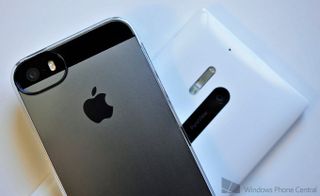Nokia Lumia 928 lags far behind the iPhone 5 in new screen latency test
A new test developed shows Apple far ahead of Android and Windows Phone for reduced display latency

When it comes to smartphones, screen response time is one of those key features that helps ensure a great user experience. Some of you may recall the use of resistive touch panels on smartphones years ago and how slow those were to respond to touch. Capacitive displays are certainly much quicker, and it’s the reason why touch-typing is so common today, having been accepted by the masses.
The question for one company though is how to measure that display latency i.e. the time it takes for the system to detect and register a touch, thereby launching an app. App streaming company Agawi has come up with a solution called TouchMarks to make accurate and quantifiable measurements in this area and the Lumia 928, while not the worst, is far behind Apple.

Devices compared include the iPhone 4, iPhone 5, Galaxy S4, HTC One and Moto X in addition to the only Windows Phone, the Nokia Lumia 928 found on Verizon. From the write up:
“As you can see, the results are remarkable. At a MART of 55ms, The iPhone 5 is twice as responsive as any Android or WP8 phone tested. All the Android devices’ MARTs fell in the same 110 – 120ms range, with the WP8-based Lumia 928 falling into that bucket as well. (Incidentally, the ranges all span about 16ms, which is expected given the 60 Hz refresh rate of these smartphones. 1/60s = 16.6ms)”
Indeed, the Lumia 928 had a response time of 117 ms whereas the iPhone 4 was at 85 ms and the iPhone 5 was even better with an extraordinary 55 ms response latency. The iPhone 5S, released this past weekend, had yet to be tested.

Why the discrepancy? Agawi has their theory:
“…Apple’s touchscreen hardware is better optimized or more sensitively calibrated for capturing and processing touch. Another possibility is that while the Android and WP8 code are running on runtimes (Dalvik and CLR respectively), the iPhone code is written in closer-to-the-metal Objective-C, which may reduce some latency. In future TouchMarks, we’ll compare C/C++-based Android apps to Java based apps to determine if this is the case.Regardless of the reasons, the conclusion is clear: the best written apps on iPhones will simply feel more responsive than similar apps on the current gen of Android devices. (We speculate this might be a major reason why the iPhone keyboard generally feels better than the Android keyboard to many people.)”
The results are fascinating, and while we can debate whether or not that extra 50 ms would really make a difference in user experience, it seems Apple has once again bested Android and Windows Phone. Microsoft is aware of this problem though as noted in the above video, where Microsoft Research is working on 'High Performance Touch'.
Agawi has open sourced the hardware and software behind TouchMarks, so people can peek at what they are doing (and try to replicate the results). The company also plans on doing future tests on other devices to see how they stack up, including the new iPhone 5S. We hope those future tests include different Windows Phones too because for all we know, the Lumia 928 is the exception and not the rule. Still, it seems clear that Apple has spent some time considering this area in engineering their phones.
Get the Windows Central Newsletter
All the latest news, reviews, and guides for Windows and Xbox diehards.
Will these results cause companies like HTC, Nokia or Samsung to reevaluate their approaches to screen calibration? We hope so as this is one important area that manufacturers won’t want to skimp out on.
Source: AppGlimse; via iMore

Daniel Rubino is the Editor-in-chief of Windows Central. He is also the head reviewer, podcast co-host, and analyst. He has been covering Microsoft since 2007, when this site was called WMExperts (and later Windows Phone Central). His interests include Windows, laptops, next-gen computing, and watches. He has been reviewing laptops since 2015 and is particularly fond of 2-in-1 convertibles, ARM processors, new form factors, and thin-and-light PCs. Before all this tech stuff, he worked on a Ph.D. in linguistics, watched people sleep (for medical purposes!), and ran the projectors at movie theaters because it was fun.
